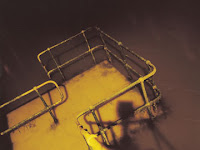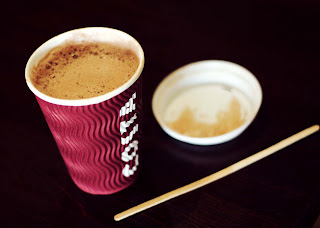I absolutely love Rut Bless Luxemburg's work; I think it is stunning, the colour tones of the images, the milky feel to them, and the luminosity of her work is just incredible. When she was a guest lecture at Burton College, she showed her work on slides rather than using a projector and they look even better on slide. She works on film as she finds it is better for the night photography that she often produces. She also works with a large format camera for resolution as she often creates 8ft prints.
 In 1995, when she studied at London College of Communication, she worked around London. She didn't want to capture the well known landmarks of the city, and wanted to show a different side of London's character though her photography, so she ventured out to find other subjects for her work. A theme she created for herself was to take images from a high perspective to hopefully achieve what she called a "speedy look, and to give the feeling of vertigo". The image opposite is one of five in a series, one of which she sold to a record company to use as an album cover.
In 1995, when she studied at London College of Communication, she worked around London. She didn't want to capture the well known landmarks of the city, and wanted to show a different side of London's character though her photography, so she ventured out to find other subjects for her work. A theme she created for herself was to take images from a high perspective to hopefully achieve what she called a "speedy look, and to give the feeling of vertigo". The image opposite is one of five in a series, one of which she sold to a record company to use as an album cover.After this cover, she was soon commissioned by the band 'Bloc Party' to create an album cover for her; I think this shows and backs up the fact that one job can lead onto another like Jon Burgerman and Studio Output discovered. Opposite is the cover she produced for them. I really like these pieces as I personally love the way she has showcased how beautiful light is at night. Although the light movement shown in her photograph for this album was slightly risky in the sense of being slightly cliché; I find that the piece works perfectly for it's purpose.
Going back to her sky scraper series, she was asked by a feminist art collector to make a project for public viewing. These images were presented in a way to show off what I would agree to be "luminocity". Luxemburg showed her work in the dark and illuminated them using back lighting. She exhibited in a similar way to Julian Germain as she also presented her work on the street. One example of where she presented her work was a dark walk way under a bridge; the idea was to make the areas appear more friendly for people using them.
As a photographer, Rut Blees Luxemburg doesn't like to edit her images, but this image opposite was an exception; originally there was a 'Coca-Cola' logo on the side of the container. For the purpose of visual communication, she removed this branding to make her image have less distractions from what she wanted her work to say. She intended this image to represent an "intimate place; a small place to create".
Another piece I cannot source included several elements to represent what she saw as security; there were leaves in the image which she feels are meant to represent a blanket, and the barbed wire and security camera are to keep unwanted threats away. I like the way that lots of elements in her photography means something to her, and each one has a representation that adds a story to her work.
A photographer that influences her as an artist is Jeff Wall, she likes the idea of water in her photography, and he talks about the water-photography relationship. Luxemburg believes that to take water and freeze it, is to be a sign of femininity. I think however, that she is influenced in a different way as he doesn't tend to use water in his photography. I think that they have similarities because both use additional objects to show a hidden meaning to what could be 'just a photograph'.
 |
| Jeff Walls - Understanding Joshua |
For example, this piece opposite by Jeff Wall is entitled "Understanding Joshua". I can see how the woman seems to be taking pity on the man in the image; but I can also see an additional represent of each person in the image. The horse ornament is a representation of the beautiful and strong, confident, woman in the photograph, which contrasts with the second ornament; a pig which represents the man. To me, I think this shows the low esteem of the man's own personal opinions of himself and the distress caused by this is clearly shown by his body language. I think that elements of these additional factors in the image have influenced Rut Blees Luxemburg as she is consciously aware of the representation within her work though the presence of certain objects. I think this shows that you can completely change the feel of an image with visual metaphors. I also like how subtle they are in this image, yet at the same time, literally highlighted. I think that these subtle touches to these artist works really transforms them and adds further all important interest to the pieces; who would look at a boring photograph for any length of time and remember anything about it?
Other interests are clearly shown in her work; nature, specifically water, as already discussed. She created another series of work that involved shooting things in the reflections of puddles. Sometimes she would create puddles to get the shot she wanted. I think this is, although obvious when discussed, more initiative than other artists; she doesn't just wait for photographs to appear in front of her and get her camera out; she creates them. I think this shows a small proportion of her dedication to her work.
 Another factor that you can see in her work is structure and architecture; she said she finds herself attached to unfinished buildings as she likes the way they have no beginning or end. I like this detail in her work as I think that the shapes are a good visual to in take. The image opposite is a strong example of this; I find it gives a feel of vertigo as well as having a strong visual structure due to the composition of the block shapes and lines within the frame. This is an image she has turned around to make more interesting and stir emotions; this is intended to give the feeling of free fall. I would say that it gives me the feeling of vertigo; so I would agree with this statement.
Another factor that you can see in her work is structure and architecture; she said she finds herself attached to unfinished buildings as she likes the way they have no beginning or end. I like this detail in her work as I think that the shapes are a good visual to in take. The image opposite is a strong example of this; I find it gives a feel of vertigo as well as having a strong visual structure due to the composition of the block shapes and lines within the frame. This is an image she has turned around to make more interesting and stir emotions; this is intended to give the feeling of free fall. I would say that it gives me the feeling of vertigo; so I would agree with this statement.All in all, I really do love her work; some are simply just beautiful, whereas others are taken even further and have strong verbal communications with you as a viewer through the use of having certain representations in shot to create visual metaphors. I think this further shows the importance of visual communication and having a connection with the viewer through this tool.
















































